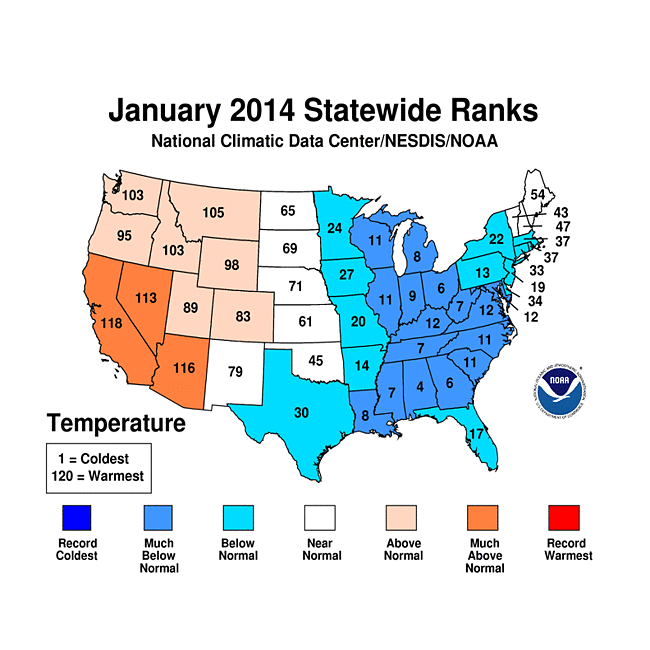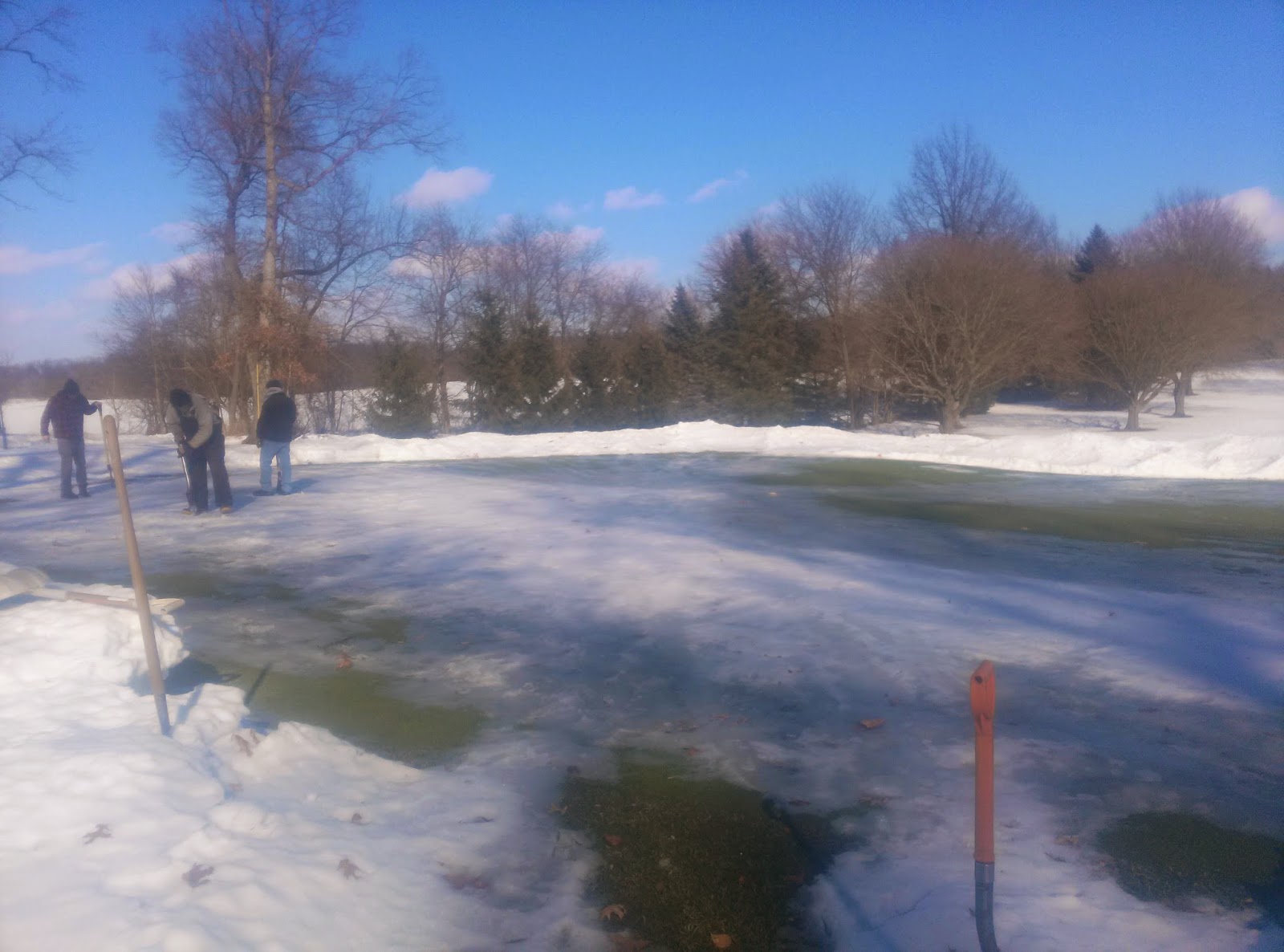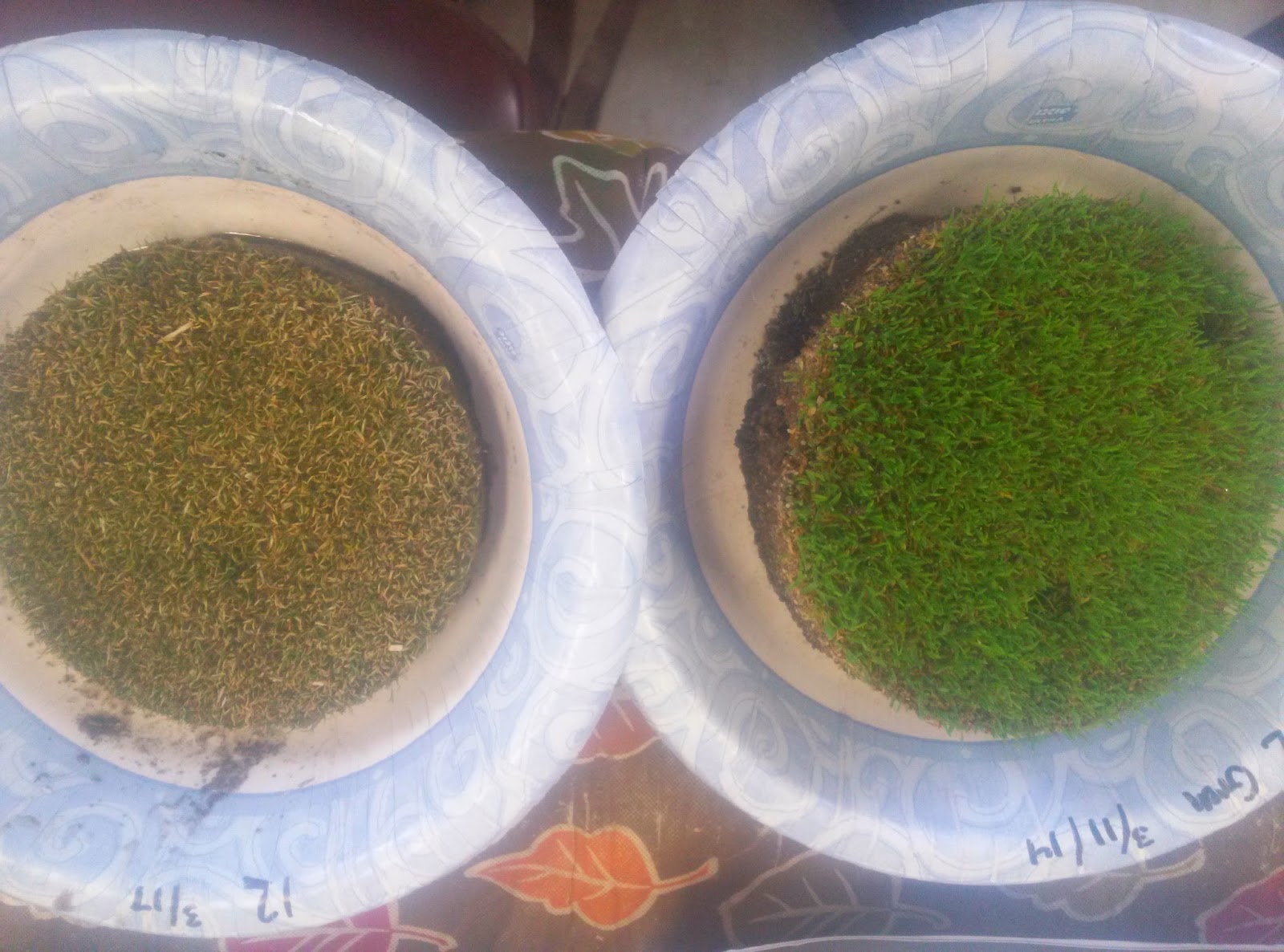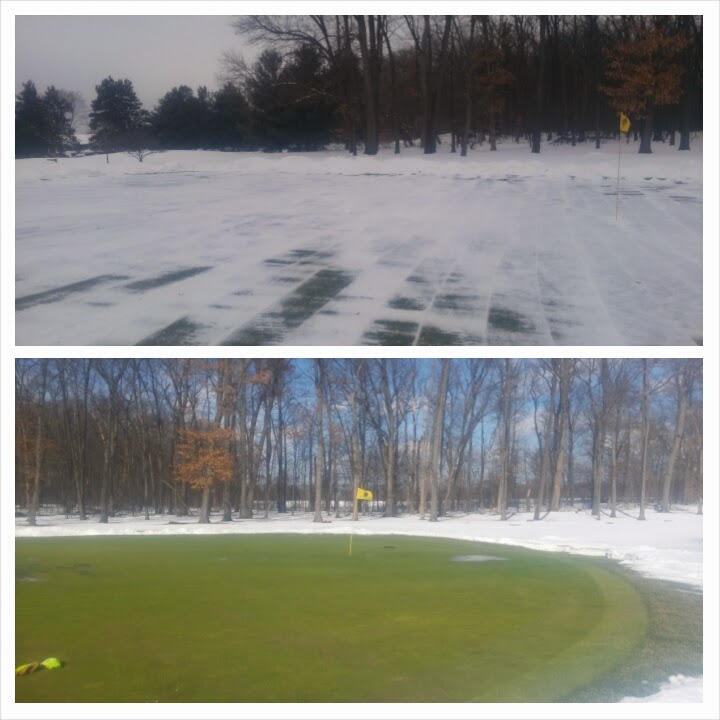This winter has been cold and long. From December 2013 through February 2014, Indiana had it’s 9th coldest winter on record and its coldest since 1979, 1978 was coldest on record (Fig. 1). With such cold temperatures, many are worried about winterkill.
 |
| Fig. 1. In the past 120 years, this was the 9th coldest winter in Indiana’s history. |
Winterkill is a catch-all term that is used to describe the loss of turf over the winter months from various causes. Turf may succumb to winter from many factors including; direct low temperatures, desiccation, ice accumulation, crown hydration, traffic and disease. While cool-season grasses are general well-adapted to “cool” temperatures, including those occurring over winter, winterkill still happens under certain conditions. Further, some species are more tolerant of low temperatures than others (Table 1).
| Table 1. Low-temperature tolerance of cool-season grasses. Adapted from Beard, 1973 and Fry and Huang, 2004. | |
| Low-temperature tolerance | Turfgrass species |
| Excellent | Roughstalk bluegrass |
| Creeping bentgrass | |
| Good | Kentucky bluegrass |
| Colonial bentgrass | |
| Creeping red fescue | |
| Medium | Tall fescue |
| Annual bluegrass | |
| Poor | Perennial ryegrass |
| Very poor | Annual ryegrass |
Causes of Winterkill
Low temperature
Turfgrasses prepare for winter by undergoing a process called “cold acclimation” in which certain sugars and proteins accumulate, cell walls become more fluid, and plant cells dehydrate. All of these changes help the plant tolerate low temperatures and prevent ice accumulation inside the plant cell, which may result in the cells rupturing.
Crown (the growing point) survival is critical to a plant’s winter survival. Located at or just below the soil surface, the crown is normally insulated by the soil. Since soil temperatures fluctuate less than air temperatures direct contact with the soil helps winter survival. This is also one reason it is recommended that closely mowed areas are topdressed just prior to winter.
Despite the plant’s best effort to protect itself from low temperatures through acclimation, plant tissues can still die. When freezing or thawing occurs quickly, damage may increase. Additionally, the freeze/thaw cycle can impact winter survival with more frequent freeze/thaw cycles being more stressful to the plant.
Desiccation
Desiccation is death from drying during winter – winter drought. Desiccation is usually greatest in areas where the soil was dry going into winter or where there was little snow cover or precipitation during winter. This is more common in the drier states like Kansas, Nebraska and the Dakotas. Turf death due to desiccation in Indiana is rare.
Ice accumulation
Ice accumulation can kill turf. When annual bluegrass (Poa annua) is covered by ice for 45 to 90 days or creeping bentgrass is covered by ice for 90 to 120 days, death can occur. Often death occurs because the ice prevents gas exchange which limits oxygen and increases carbon dioxide to toxic levels.
Crown hydration
Crown hydration is the phenomenon by which deacclimating plant cells in the crown tissue of the turf can be damaged by ice crystallization causing plant cells to rupture and plants to die. This phenomenon is most common for annual bluegrass as it is quicker to break winter dormancy and begin taking up water than species like creeping bentgrass. The most common time for this phenomenon to occur is in late winter and early spring, during or after snow melt and during periods of rainfall followed by freeze/thaw cycles.
Disease
Snow mold diseases commonly damage turf during the winter months. Typhula snow molds (gray snow mold and speckled snow mold) and/or pink snow mold are problematic throughout the Midwest. For more information on these diseases, see our recent post at http://purdueturftips.blogspot.com/2014/03/snow-molds-in-winter-of-2013-14.html
Areas Prone to Winterkill
For the reasons discussed above and further addressed below, the following areas are more prone to winterkill.
- Turf planted with species that have poor or very poor low-temperature tolerance
- Immature seedling turf planted in late fall – especially tall fescue, annual ryegrass and perennial ryegrass
- Low spots with poor drainage
- Close mown turf – fewer carbohydrates
- Exposed areas prone to desiccation – not as problematic in Indiana as farther west
- Turf covered in ice for more than 45 days – especially annual bluegrass
- Areas trafficked during winter
- Malnourished turf – inadequate nitrogen fertilization or low soil potassium
- Shaded turf
- Species prone to pink snow mold like annual bluegrass and creeping bentgrass
How to Assess the Potential Damage
If you think your turf might be damaged, use a cup-cutter or spade on thawed turf areas or a drill and a hole saw on frozen areas to remove a plug from the area in question. Take several samples from both probable damaged areas as well as areas that you think are undamaged. Clearly label which plugs are which and then place them in a sunny window or in a well-lit are under a lamp. Keep them watered and watch for recovery.
Hopefully, spring will arrive soon and warmer temperatures should allow for the field examination of new growth and a better overall assessment of potential damage.
Level of Damage Reported in Indiana
Aside from some visible snow mold damage in areas where the snow has melted, the most likely damage we will see this winter will be from ice accumulations on annual bluegrass turf. We don’t anticipate much direct, low-temperature winterkill because much of the turf was insulated during our coldest temperatures. Superintendents whom we have corresponded with have sampled their turf and reported good green-up of ice covered turf (Fig. 2).
Please contact us if you are seeing significant turf injury due to potential ice accumulation or low temperatures.
Recovery of Lawn & Athletic Turf
In higher mowed turf like lawns or athletic turf we don’t anticipate much winterkill, except where areas received traffic. There may be more snow mold on areas were snow was piled next to streets and driveways or where snow drifted and accumulated. These piles should melt but in some areas, they may need to be removed to help the turf recover and begin to grow once temperatures moderate. A light raking of areas matted from snow accumulation or from snow mold will speed turf recovery and green-up.
If areas are predominately Kentucky bluegrass and you experienced some damage from snow molds, mechanical damage (such as a snow plow that went out-of-bounds), or even some loss of perennial ryegrass, one option is simply to do nothing and allow the Kentucky bluegrass to recover these areas through its spreading (rhizomatous) growth habit.
If a spring seeding is necessary to repair damaged areas, consider doing it before the ground completely thaws from winter. Although it is not necessary to seed before the ground thaws it may make seeding easier as soils are often soft and moist in the spring which may make it more difficult to seed certain areas, especially with heavier equipment. When seeding small areas, prep the soil by scratching the surface with a rake to increase seed to soil contact. Larger areas can be seeded with a slit seeder or aerification followed by seeding although it will be difficult to get equipment out onto the turf until temperatures warm and the soil dries.
Seed planted now will lie dormant until the soil temperatures warm in April. Spring seedings are more successful with tall fescue and perennial ryegrass than with Kentucky bluegrass. This is due to the faster germination rate and better seedling vigor of perennial ryegrass and tall fescue compared to Kentucky bluegrass.
If Kentucky bluegrass is seeded in the spring consider using a mixture of turf-type tall fescue: Kentucky bluegrass (90:10, weight: weight) or a mixture of Kentucky bluegrass:perennial ryegrass (such as 80:20, weight: weight)(Table 2). Seeding Kentucky bluegrass alone in the spring will result in marginal bluegrass establishment due to the slow germination and seedling vigor and increased competition from crabgrass.
Table 2. Recommended seeding rates for lawns in Indiana.
| Species |
Seeding
rate lbs/1,000 ft2 |
Days to
germinate |
| Kentucky bluegrass |
1.0 to 2.0
|
10-21
|
| Kentucky bluegrass (80-90%) + perennial ryegrass (10-20%) |
3.0 to 6.0
|
5-21
|
| Tall fescue |
8.0 to 10.0
|
6 to 10
|
| Tall fescue (90%) + Kentucky bluegrass (10%) |
5.0 to 7.0
|
6 to 21
|
Ideally a soil test should be conducted prior to planting any seed to determine phosphorus levels. Where a soil test shows deficiency and to help the seedlings establish, apply a “starter fertilizer” after emergence to enhance seedling development. Starter fertilizer is high in phosphorus (P) which is listed as the second number in the analysis on the fertilizer bag. For instance, a 16-22-8 fertilizer contains 22% P2O5. Apply the fertilizer according to the label directions would should supply at least 1.0 lb. P2O5 /1000 ft2. This application will likely include nitrogen (first number in the fertilizer analysis), which will also help the seedlings develop an extensive fibrous root system that is better able to take up nutrients and obtain water.
Early spring preemergence herbicides are often necessary in Indiana to prevent troublesome summer annual grassy weeds such as crabgrass and goosegrass. Keep in mind that all preemergence herbicides (except Tupersan) work to prevent the emergence of turfgrass seeds as well as weed seeds, so do not reseed areas treated with a preemergence herbicide this spring or do not apply a preemergence herbicide if you plan on seeding.
If you need to reseed an area that it likely to have crabgrass, there are some different approaches that you can take to manage crabgrass in spring seeding.
- Tupersan (siduron) may be used for preemergence control of annual grassy weeds in newly seeded cool-season turf. Check the label for rates and use directions. This herbicide is more expensive and short-lived, but it is the only safe preemergence herbicide to apply at the time of seeding. Tenacity and Pylex are postemergence herbicides with preemergence activity that are also safe to apply at the time of seeding fine fescue, Kentucky bluegrass, perennial ryegrass, and tall fescue.
- Another strategy is to use a postemergence herbicide in late May and June that is safe to use on seedling turf instead of a preemergence herbicide to control crabgrass. Options include Drive (quinclorac), Tenacity (mesotrione), Pylex (topramezone) and SquareOne (quinclorac + carfentrazone). These products can be most safely used very soon after seeding to control crabgrass (see label for exact details on each turf species). If the seedlings are more mature (mown 2-3 times following their emergence) then other products such as Q4 Plus (quinclorac + sulfentrazone + 2,4-D + dicamba), Onetime (quinclorac + MCPP + dicamba), or Solitare (quinclorac + sulfentrazone) can also be used. For homeowners, there are now several products that contain quinclorac which can be used. Look for quinclorac in the list of ingredients on the label. An advantage of this strategy is that most of these products will also provide good postemergence broadleaf weed control.
- A third option is to use Dimension (dithiopyr) in late May after a spring seeding to control newly germinated crabgrass that has emerged and is still at the 1-4 leaf stage prior to tillering. Dimension is the only preemergence herbicide which has good postemergence activity on newly germinated crabgrass. This application would also prevent future crabgrass germination through the rest of the summer in newly seeded areas. The assumption in this scenario is that the seedlings were planted in early spring and that they have developed enough of a root system to tolerate an application of a preemergence herbicide in late May.
Recovery of Putting Green Turf
If your putting greens were predominantly annual bluegrass and you would like the composition to remain so, then scratching/scarifying the surface to allow annual bluegrass to germinate in these thin areas is the best approach.
Most golf course superintendents will want to try and repair damaged areas with creeping bentgrass. Doing so can be difficult as bentgrass seedlings are not very competitive, traffic tolerant, or quick to germinate during cool-springs. The best approach to getting creeping bentgrass to establish is to:
- Prep the seedbed using solid tine aerification, core aerification, verticutting, spiking, or using other aerification attachments such as the Job-Saver to increase the potential for seed-to-soil contact. Use an improved cultivar of creeping bentgrass. See the article “Evaluation of Putting Green Bentgrass Cultivars and Blends” in our 2011 Purdue research report for more information.
- Light applications of soluble nitrogen (like urea) at 0.1 to 0.4 lbs N/1000 ft2 every 7-21 days following seedling emergence should help putting green recovery and seedling establishment.
- Apply fungicides as needed to prevent additional spring diseases such as brown ring patch, Microdochium patch, and yellow patch.
Looking to the Future: How to Enhance Winter Survival and Minimize Future Losses
The most important factor in minimizing future winterkill is to plant low temperature tolerant turfgrasses. For example, a weed control program designed to reduce annual bluegrass in putting greens and increase creeping bentgrass will reduce the likelihood of future winter injury (NOTE: At Purdue, we are initiating a 2-year, USGA-funded experiment on annual bluegrass control in putting greens in April 2014).
While there are differences in percent winterkill among perennial ryegrass cultivars in northern research locations (http://ntep.org/data/pr04/pr04_10-11f/pr0410ft26.txt), a better approach would be to use a more winter hardy species like Kentucky bluegrass.
Physically remove ice (it’s hard work) from areas of high economic importance like golf course putting greens (Figs. 3 and 4).
 |
| Fig. 3. Photo taken on a putting green during the ice removal process after about 60 days of ice encasement. Photo courtesy Ryan Cummings, Superintendent Elcona CC, Bristol, IN. |
Another approach to help remove ice accumulation is to topdress the ice with dark colored material such as milorganite (6-2-0), sunflower seeds, dark-colored or black sands, or other materials which will help increase heat absorbance and subsequently help to melt the ice.
Current research at Michigan State Some research is evaluating safer ice melt materials for their potential use as well. See this link for more information: http://www.msuturf.blogspot.com/2014/02/melting-ice-sheets-on-greens.html
Ensure that turf is receiving adequate nitrogen fertilization in the autumn months prior to winter. Nitrogen fertilization in autumn will help the plant produce valuable carbohydrates needed for overwintering and spring regrowth.
Improve drainage to reduce winterkill potential. Improving drainage (including opening up drain covers to allow draining during melting) will reduce ice formation (and depth) following thaws or mixed precipitation in winter.
There are mixed reports about the influence of potassium (K) fertilization on the winter survival of turfgrasses as some experiments have found potassium fertilization improved winter hardiness and others found no improvement in winter hardiness following potassium fertilization. Our recommendations are to use soil tests to determine if you need to make supplemental potassium applications. If your soil already has adequate levels of potassium, then it is not likely that additional potassium fertilization will improve winter hardiness.
Remove traffic from high value areas during winter as the turf can be damaged from traffic when the soil is frozen or when there is frost on leaf and stem tissues.
Both pink and gray snow mold can damage turf during winter. Some species are particularly susceptible to pink snow mold such as annual bluegrass and creeping bentgrass while gray snow mold causes similar levels of damage across turf species. Fungicides can be effective in preventing/reducing damage. More detailed information about snow mold diseases is presented at the following links.
http://www.extension.purdue.edu/extmedia/BP/BP-101-W.pdf (gray snow mold) http://www.extension.purdue.edu/extmedia/BP/BP-102-W.pdf (pink snow mold)
Shaded turf grows less vigorously during the growing season and often has fewer stored carbohydrates prior to the onset of winter. Additionally, shaded areas have cooler soils and are slower to warm/thaw following winter and are more likely to retain snow cover. As such, reducing shade on turf species that have poor low temperature tolerance is another strategy to increase winter survival. This includes removal of tree leaves in autumn shortly after they fall to encourage turf photosynthesis and carbohydrate storage.
Conclusion
Many factors have the potential to contribute to winterkill. Some of these factors are outside of our control and are dependent strictly on weather while other factors can be manipulated through sound cultural management to reduce potential for winterkill. Through sound turf management we can reduce the risk of winterkill but we can’t reduce the risk of winter. Spring will come eventually!
Aaron Patton and Cale Bigelow, Purdue Turf Program
References
- Beard, J.B. 1973. Turfgrass: Science and Culture. Englewood Cliffs, NJ. Prentice Hall.
- Fry, J. and B. Huang. 2004. Applied Turfgrass Science and Physiology. Hoboken, NJ: J. Wiley.
- Beard, J.B. 1964. Effects of ice, snow and water covers on Kentucky bluegrass, annual bluegrass and creeping bentgrass. Crop Science 4:638-640.
- Stier, J. C., and S.-z. Fei. 2008. Cold-stress physiology and management of turfgrasses. In Pessarakli, Mohammad (ed.) Handbook of Turfgrass Management and Physiology. Boca Raton, Florida: CRC Press.
- Tompkins, D.K., J.B. Ross, and D. L. Moroz. 2004. Effect of ice cover on annual bluegrass and creeping bentgrass putting greens. Crop Science 44:2175-2179.

